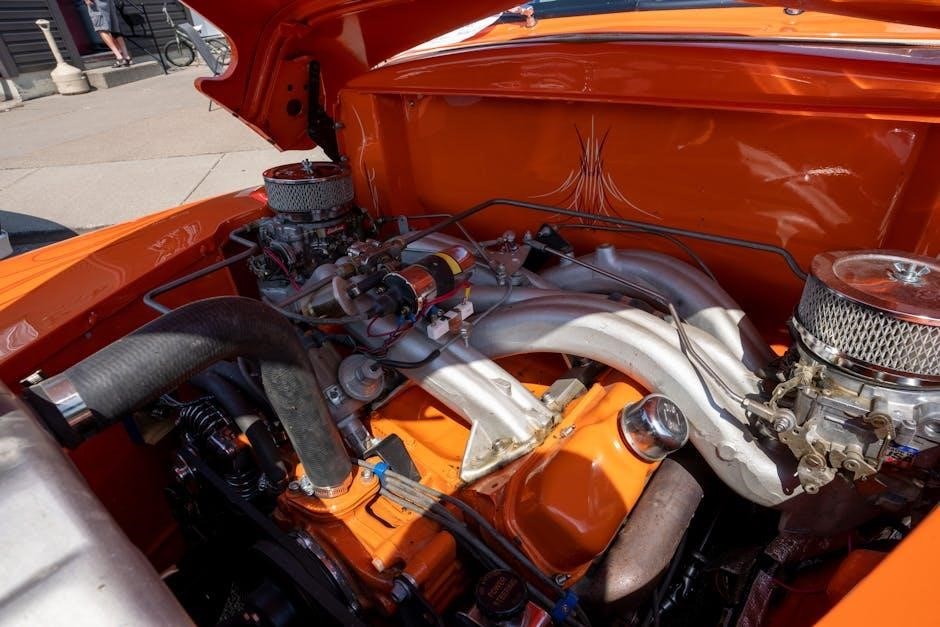Carburetor tuning is essential for optimizing engine performance, fuel efficiency, and reliability. It involves adjusting the air-fuel mixture to ensure proper combustion and power delivery across all RPM ranges.
1.1 Overview of Carburetors and Their Importance
A carburetor is a critical component in internal combustion engines, responsible for mixing air and fuel to create the optimal mixture for combustion. Its design ensures proper fuel delivery across various engine speeds, making it essential for performance, efficiency, and reliability. Understanding its operation is key to effective tuning, as it directly impacts power output, fuel consumption, and emissions. Proper tuning ensures a smooth and efficient engine operation.
1.2 Why Carburetor Tuning is Necessary
Carburetor tuning is crucial for ensuring the proper air-fuel mixture, which directly impacts engine performance, efficiency, and longevity. Incorrect tuning can lead to poor idle, reduced power, and increased emissions. Regular tuning adjusts the mixture to meet specific engine needs, ensuring optimal combustion, smooth operation, and compliance with emissions standards. It also prevents damage from lean or rich conditions, making it essential for maintaining engine health and reliability over time.

Understanding Carburetor Components
A carburetor consists of key parts like the float bowl, main jets, throttle, and venturi. These components work together to deliver the precise air-fuel mixture to the engine for combustion.
2.1 Main Components of a Carburetor
The primary components of a carburetor include the float bowl, which stores fuel, the venturi, where airflow accelerates to draw fuel, and the throttle valve, controlling airflow. Additionally, jetting components like the main jet and pilot jet regulate fuel flow at different engine speeds. These parts work harmoniously to deliver the optimal air-fuel mixture for efficient combustion and performance.
2.2 How Carburetor Components Interact
Carburetor components interact through a precise sequence of airflow and fuel delivery. As air flows through the venturi, it creates a vacuum that pulls fuel from the float bowl through the main jet. The throttle valve modulates airflow, while the pilot jet ensures proper fueling at idle. This synchronized process maintains the ideal air-fuel ratio for smooth engine operation across all RPM ranges.

Preparing for Carburetor Tuning
Before tuning, ensure your carburetor is clean and free from debris. Gather essential tools like a screwdriver set and jetting gauges for precise adjustments. Always refer to your carburetor’s manual for specific instructions to avoid errors during the process.
3.1 Essential Tools for Carburetor Tuning
Carburetor tuning requires specific tools, including a screwdriver set, jetting gauges, and a tachometer to monitor RPM. A clean workspace and protective gear are also essential. Ensure you have replacement jets and gaskets on hand to avoid delays. Referencing a detailed manual or online guide can provide step-by-step instructions for accurate adjustments and troubleshooting common issues during the tuning process.
3.2 Safety Precautions and Workspace Setup
Ensure a well-ventilated workspace to avoid inhaling fuel vapors or carburetor cleaners. Wear protective gloves and eyewear to prevent chemical exposure. Keep a fire extinguisher nearby and avoid open flames. Use a stable workbench with a clean, dry surface to prevent damage to components. Properly dispose of hazardous materials and follow local safety regulations to maintain a safe environment during tuning.

Adjusting the Idle Mixture
Adjusting the idle mixture ensures proper engine operation at low RPM. Start by warming the engine, then fine-tune the mixture screws for optimal performance and emissions.
4.1 Locating and Accessing Idle Mixture Screws
Idle mixture screws are typically located near the throttle shaft and regulate fuel flow at low RPM. Start by locating these screws, often marked with an “L” or “I.” Use a screwdriver to adjust them gently, turning both screws equally for a balanced mixture. Begin with small increments, testing the engine’s response to ensure smooth operation and minimal emissions.
4.2 Step-by-Step Process for Adjusting Idle Mixture
Warm the engine to operating temperature. Turn the idle mixture screws counterclockwise to richness or clockwise for leanness. Use a screwdriver to adjust both screws equally, checking RPM and engine smoothness. After each adjustment, allow the engine to stabilize before re-evaluating. Fine-tune until the idle is smooth and RPM is stable, ensuring optimal performance and minimal emissions. Test and repeat as needed for precision.

Jetting and Re-Jetting the Carburetor
Jetting involves replacing or adjusting carburetor jets to optimize the air-fuel mixture. Main jets, pilot jets, and air jets must be precisely matched to engine specifications for peak performance.
5.1 Understanding Main Jets, Pilot Jets, and Air Jets
Main jets regulate fuel flow at high RPM, pilot jets control low-speed operation, and air jets fine-tune the mixture. Each plays a crucial role in balancing performance, efficiency, and smooth engine operation across all conditions.
5.2 How to Choose the Right Jets for Your Carburetor
Selecting the correct jets involves understanding your engine’s demands. Start with the main jet, ensuring it matches your engine’s airflow. Adjust the pilot jet for smooth idle and low-end response. Fine-tune with the air jet to achieve an optimal mix. Test and refine to avoid lean or rich conditions, ensuring peak performance and efficiency.
5.3 Installing and Testing New Jets
After selecting the jets, install them carefully to avoid damage. Reassemble the carburetor and reconnect all components. Start the engine, letting it warm up fully. Test under load and at various RPMs to ensure smooth operation. Monitor for any signs of lean or rich conditions, adjusting as needed for optimal performance and efficiency.

Fine-Tuning the Air-Fuel Mixture
Fine-tuning the air-fuel mixture ensures optimal engine performance and efficiency. Start rich, then adjust for smooth operation across all RPMs to prevent damage and improve combustion.
6.1 Understanding the Air-Fuel Ratio and Its Impact on Performance
The air-fuel ratio is crucial for engine efficiency and power. A stoichiometric ratio of 14.7:1 is ideal for most engines, balancing fuel efficiency and power. Too rich (more fuel) reduces efficiency, while too lean (more air) risks engine damage. Proper adjustment ensures smooth combustion, optimal performance, and prevents issues like overheating or poor idle quality.
6.2 Adjusting the Throttle Slide and Needle
Adjusting the throttle slide and needle fine-tunes the air-fuel mixture at various throttle positions. The throttle slide controls airflow, while the needle regulates fuel flow. Start by ensuring the engine is warm, then adjust the needle in small increments, testing performance. Use a tachometer to monitor RPM smoothness. Proper adjustment ensures optimal power delivery and prevents issues like bogging or surging.
High-Performance Carburetor Modifications
Upgrading to high-performance carburetors and components enhances power output and efficiency. Modifications include installing larger jets, performance throttle slides, and aftermarket carbs designed for specific engines and applications.
7.1 Upgrading to a Performance Carburetor
Upgrading to a performance carburetor can significantly enhance engine power and efficiency. Performance carbs feature larger bores, optimized venturi designs, and adjustable components. They are tailored for specific applications, ensuring better airflow and fuel distribution. This upgrade is ideal for high-performance vehicles or race engines, where precise control over the air-fuel mixture is critical for maximum output and reliability.
7.2 Advanced Tuning Techniques for Maximum Power
Advanced tuning involves precision adjustments to the carburetor’s internal components, such as modifying the venturi, installing high-flow jets, and optimizing the throttle slide. These techniques ensure maximum airflow and fuel delivery, particularly at high RPMs. Expert tuners often experiment with different needle configurations and jetting combinations to achieve the perfect balance of power and efficiency, tailored to specific engine setups and performance goals.

Regular Maintenance and Cleaning
Regular maintenance ensures optimal carburetor performance. Clean or replace filters, inspect for wear, and flush fuel passages. Disassemble and soak parts in solvent periodically for thorough cleaning.
8.1 Importance of Regular Maintenance
Regular maintenance is crucial for maintaining carburetor performance and longevity. Over time, dirt, debris, and fuel residue can clog jets and passages, reducing efficiency. Cleaning or replacing filters and inspecting components ensures proper fuel flow and air-fuel mixture. Neglecting maintenance can lead to poor engine performance, decreased fuel efficiency, and potential damage to the carburetor and engine. Consistent upkeep ensures reliability and optimal operation.
8.2 Cleaning the Carburetor and Its Components
Cleaning the carburetor and its components is vital for maintaining proper function. Use a carburetor cleaning solvent to remove dirt, varnish, and fuel residue. Disassemble the carburetor, soak parts, and scrub with a soft brush. Pay attention to small passages, jets, and the bowl area. Ensure all components are dry before reassembly. Regular cleaning prevents clogging, improves fuel flow, and ensures optimal engine performance and efficiency.
Troubleshooting Common Issues
Identify symptoms like rough idle or poor acceleration. Check for clogged jets, faulty mixture screws, or vacuum leaks. Adjust settings to restore proper engine performance and efficiency.
9.1 Identifying and Fixing a Lean or Rich Condition
A lean condition occurs when there’s too much air, causing high temperatures and potential engine damage. A rich condition results from excess fuel, leading to poor mileage and emissions. Check the air-fuel mixture by monitoring engine performance, spark plug color, and adjusting the idle mixture screws accordingly. Fine-tuning the jets and needle settings can resolve these issues effectively.
9.2 Solving Problems Related to Idle and Acceleration
Idle issues, such as rough running or stalling, often stem from incorrect idle mixture settings. Adjusting the idle mixture screws to achieve a smooth idle can resolve these problems. For acceleration issues, ensure the throttle slide and needle are properly aligned and not worn. Cleaning or replacing the accelerator pump can also improve throttle response and eliminate hesitation during acceleration.
Case Studies and Real-World Applications
Real-world examples demonstrate how proper carburetor tuning enhances performance. Case studies reveal insights from various models, showcasing successful modifications and the lessons learned to achieve optimal engine efficiency.
10.1 Examples of Successful Carburetor Tuning
Successful carburetor tuning examples include adjusting the idle mixture on an Edelbrock 650 cfm for emissions compliance and re-jetting a Keihin carb to improve horsepower. Proper jetting, such as switching to a 145 main jet, resolved lean conditions in a Mikuni setup. These real-world applications highlight how precise adjustments can optimize performance, fuel efficiency, and reliability across various engines and driving conditions.
10.2 Lessons Learned from Different Carburetor Models
Lessons from various carburetor models reveal that understanding component interactions is crucial. For instance, the Holley 4BBL and Keihin carbs demonstrate how jetting and idle adjustments impact performance. The Mikuni carb’s need for precise air-fuel ratios shows the importance of tuning techniques. These insights emphasize the value of tailored approaches for different carburetors to achieve optimal engine operation and efficiency.
Mastering carburetor tuning enhances engine performance and efficiency. For further learning, explore detailed manuals, specialized tools, and online forums. These resources provide practical insights and expert advice to refine your tuning skills effectively.
11.1 Summary of Key Takeaways
Carburetor tuning is crucial for optimizing engine performance, fuel efficiency, and reliability. Proper techniques ensure the right air-fuel mixture for smooth operation. Understanding components, adjusting idle mixtures, and re-jetting are essential skills. Regular maintenance and troubleshooting common issues like rich or lean conditions are vital. Always use the right tools and follow safety guidelines for effective tuning and to avoid damage to your engine.
11.2 Recommended Tools, Manuals, and Online Resources
Essential tools include a screwdriver set, air-fuel mixture gauge, and vacuum gauge. Manuals like the Holley or Edelbrock tuning guides provide detailed instructions. Online forums such as Reddit’s r/CarTalk and specialized carburetor communities offer valuable insights. YouTube tutorials and workshops can also enhance your skills. Always refer to manufacturer-specific resources for accurate information.